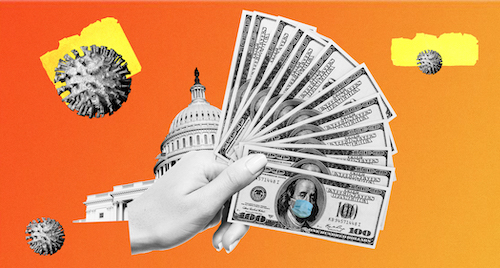Miranda, who gives her business students tools for understanding the operation of the economy as a whole, said taxpayers today pay for the stimulus packages from the 2008 recession. And those packages brought needed relief and — having the benefit of hindsight — an improved economic situation that outweighed the costs. So it’s all about the return on investment.
Looking at the newer stimulus and relief packages — the CARES Act, the Pandemic Relief Bill and the American Rescue Plan Act — Miranda relies on economics research, history and her financial expertise to put the debt into perspective and share what the long-term economic effects may be.
Q: At an estimated 10.3% of gross domestic product (GDP), the deficit in 2021 would be the second largest since 1945. Should we be concerned about our economy running such a large deficit?
Mercedes Miranda: A large amount of debt is concerning. But you also need to put it into perspective. A lot of folks think of the trillions of dollars of debt, but do not think of what that debt actually looks like. Typically, people's home debt is about 300% their yearly salary. The U.S. debt to GDP ratio is around 100% indicating the U.S. income is around the same as our current debt.
There is a new line of thinking that is to not worry about debt levels or a balanced budget. Former Treasury Secretary Lawrence Summers and Jason Furman of Harvard claim that debt-to-GDP ratios are not the correct metric of fiscal sustainability. These ratios do not account for the fact that both the present value of GDP has increased, and debt service costs have decreased as interest rates have fallen.As a matter of fact, interest rates are lower than the nominal growth rate of the economy (before adjusting for inflation). In this scenario, debt will continue to shrink as a share of GDP over time. The common belief is that budgets must be balanced in the long run. However, if the U.S.economy grows at a faster rate than interest builds up, the government could run a small deficit forever.
Q: But what about the burden to future generations?
MM: Future generations will likely benefit too because government fiscal stimulus lowers the risk of a longer more painful recession and long-term scarring of the economy later on. One thing we want to avoid is sustained periods of slow growth which increase the risk of future recessions and depressed economies. The Biden administration’s “act big” rationale with the recent $1.9 trillion bill comes from the evidence from the post-2008 period.
I should add that the U.S. isn’t worried about being able to finance more deficit spending because investor appetite for Treasury debt remains strong. In our current economy, the U.S. government can borrow at very low interest rates by historical standards. Interest rates are not expected to rebound any time soon and the risk of inflation remains in the lower side, so taking action now makes sense.
Q: What’s the evidence from the post-2008 period to “act big”?
MM: Prior to the pandemic, the latest stimulus was during the recession of 2008-2009. In the last quarter of 2008, the American economy contracted by a shocking 8.9%. By early 2009, job losses hit 800,000 a month. Then President Obama signed the American Recovery and Reinvestment Act (ARRA) in February 2009. There’s widespread agreement among economists that this stimulus act helped boost the economy.
But, with the benefit of hindsight, many economists now believe that the Obama Reinvestment Act would have stimulated more economic growth if the Reinvestment Act stimulus package had been much bigger. Even 10 years after the 2008 financial crisis, the U.S. economy did not return to the pre-crisis output levels. One lesson learned is that the U.S. has a greater room for economic growth and higher employment rates without worrying about inflation. In the long run, we must go beyond emergency efforts to stimulate economic recovery. That is why infrastructure spending, especially with a focus on “green” and competitive jobs, must be a high priority.
Q: These recent measures have definitely been bigger. It may be too soon to tell, but have they been effective?
MM: In the last year alone, massive fiscal support has proved remarkably effective. Starting with the Coronavirus Aid Relief and Economic Security (CARES) Act in March 2020. This $1.8 trillion economic stimulus bill was passed by Congress and signed into law by President Trump to limit the economic impact of the COVID-19 pandemic to support American families, workers and businesses. In a study of its economic impact, the authors find that programs under the CARES Act succeeded in mitigating economic losses in welfare by around 20% on average.
A more recent study by the Brookings Institute estimates that President Biden’s $1.9 trillion package would boost economic activity. They project an increase in real gross domestic product (GDP) of 4% at the end of 2021. GDP would reach the Congressional Budget Office’s pre-pandemic GDP projection after the third quarter of 2021, exceeding it by 1% in the fourth quarter. Without Biden’s recent stimulus package, the GDP would remain below the pre-pandemic level for the next several years because additional federal resources are needed to distribute vaccines and combat any potential resurgence of the pandemic.
U.S. Treasury Secretary Janet Yellen reassured us that the $1.9 trillion package could bring the economy back to full employment before the end of 2021. Just in the month of March, the US added 916,000 new jobs, increasing hopes that vaccinations and reopening of businesses are giving the economic recovery a firmer grip. However, we still have a long way to go. There were roughly 8.4 million fewer jobs in March 2021 than a year ago. The unemployment rate last month was still 6% compared to 3.5% a year ago (Feb. 2020).
Q: Earlier you mentioned that inflation remains on the lower side. But with any big spend, isn’t there a risk of rising inflation?
MM: As we all know, inflation decreases people's ability to pay for goods. My favorite definition of inflation is too much money chasing too few goods. At the moment, there are no signs of significant inflation. Some may point to the housing market, but Federal Reserve Chairman Jerome Powell said he sees the rising home prices as a temporary reaction to the COVID-19 crisis, with people switching residences to adapt.
The Fed expects some consumer price inflation for goods like cars and clothing and services like haircuts and hospital care to pick up in the months ahead, though they don’t expect that will be lasting. The Federal Reserve seeks “inflation moderately above 2% for some time” before it will consider raising interest rates, which would slow inflationary pressures if needed.
It’s also important to know that a mild level of inflation is good because it motivates consumers to buy now rather than wait and pay more later. As a result, it increases demand in the short term. Businesses sell more and factories produce more and are more likely to hire new workers to meet demand. It creates a snowball effect, boosting economic growth.
Q: So there have been short-term pros like unemployment recovery, safety nets for the less fortunate and boosted economic activity. What long-term effects may these bills have?
MM: So far, the economy has followed a K-shaped recovery, which shows a portion of the population and businesses recovering quickly and fully, while another suffers a great deal. Low-wage workers experienced much larger job losses that persist today aggravating long-standing socio-economic disparities in living standards. The packages, especially the most recent one, looked at ways to reduce these disparities.
This government assistance could lead to a possible long-term effect: Temporary expansion of government power tends to become permanent. The government may plan to boost spending only for a short period (during the crisis). But then prospects change, making such expansionism difficult to undo. I don’t see a problem with the size of government in the long run — as long as resources are used in an efficient way like shifting the spending to areas that create the most jobs.
Economist Mariana Mazzucato presents a challenge to the dominant understanding of government's role in the U.S. economy: "Not only has government funded the riskiest research, whether applied or basic, but it has indeed often been the source of the most radical, pathbreaking types of innovation. To this extent it has actively created markets, not just fixed them.” In the book “Mission Economy” she argues that by deploying the power of the state in practical ways, societies can become more prosperous and equitable. These relief and stimulus packages may have created an avenue for this to happen.
Interview by Sarah Tuxbury. If you’re a member of the media and would like to speak with COB Faculty Mercedes Miranda about this topic, please drop us a line at UMDearborn-News@umich.edu.







